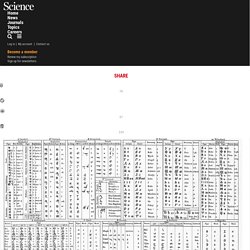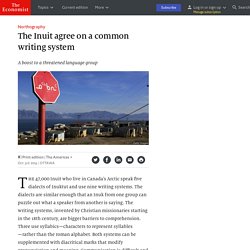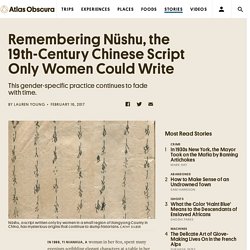

Who Invented the Alphabet? Centuries before Moses wandered in the “great and terrible wilderness” of the Sinai Peninsula, this triangle of desert wedged between Africa and Asia attracted speculators, drawn by rich mineral deposits hidden in the rocks.

And it was on one of these expeditions, around 4,000 years ago, that some mysterious person or group took a bold step that, in retrospect, was truly revolutionary. Scratched on the wall of a mine is the very first attempt at something we use every day: the alphabet. The evidence, which continues to be examined and reinterpreted 116 years after its discovery, is on a windswept plateau in Egypt called Serabit el-Khadim, a remote spot even by Sinai standards. Yet it wasn’t too difficult for even ancient Egyptians to reach, as the presence of a temple right at the top shows. Curators on Camera: An iconic Chinese typewriter. A to Z: How Writing Changed the World. The Case for Hangul as the World’s Easiest Writing System. Languages - Real Chinese - Mini-guides - Chinese characters. Inventing Graphics on Cave Walls. Thoth's Pill - an Animated History of Writing. Why written languages look alike the world over.
What do Cyrillic, Arabic, Sanskrit, and 113 other writing systems have in common?

Different as they appear at first glance, they share basic structural features, according to a new study: characters with vertical symmetry (like the Roman letters A and T) and a preference for vertical and horizontal lines over oblique lines (like those in the letters X and W). The explanation appears to be rooted in the wiring of our brain. “People appear to have an aesthetic preference for certain kinds of shapes and designs, and that preference seems to explain the writing systems we see,” says Julie Fiez, a psychologist at the University of Pittsburgh in Pennsylvania who was not involved in the study. Fiez, who studies the neuroscience of reading, says those features may tap into how our eyes and brains process images: Neurons fire faster at the site of objects that display vertical symmetry—like human faces—and horizontal and vertical lines, which are common in natural landscapes.
The Inuit agree on a common writing system - Northography. THE 47,000 Inuit who live in Canada’s Arctic speak five dialects of Inuktut and use nine writing systems.

The dialects are similar enough that an Inuk from one group can puzzle out what a speaker from another is saying. The writing systems, invented by Christian missionaries starting in the 18th century, are bigger barriers to comprehension. Three use syllabics—characters to represent syllables—rather than the roman alphabet. Both systems can be supplemented with diacritical marks that modify pronunciation and meaning. Communication is difficult and translating textbooks and government documents expensive. Partly because of these difficulties, Inuktut, a group of languages spoken by 39,000 Inuit, is giving ground to English. Get our daily newsletter Upgrade your inbox and get our Daily Dispatch and Editor's Picks. On September 26th Inuit Tapiriit Kanatami, the national Inuit organisation, decided to mitigate these difficulties by adopting a unified writing system.
The alphabets at risk of extinction - BBC Future. On his first two days of school, in a village above the Bangladeshi port of Chittagong, Maung Nyeu was hit with a cane.

This was not because he was naughty. It was simply that Nyeu could not understand what the teacher was saying, or what was written in his textbooks. Although 98% of Bangladeshis speak Bengali as a first language, Nyeu grew up with Marma, one of several minority tongues in the region. Written, it is all curls, like messy locks of hair. Eventually Nyeu managed to escape this cycle of bewilderment and beatings. Remembering Nüshu, the 19th-Century Chinese Script Only Women Could Write. In 1988, Yi Nianhua, a woman in her 80s, spent many evenings scribbling elegant characters at a table in her kitchen in a small rice-farming village in Shangjiangxu, China.

With only a blunt writing brush, the elongated script came out fat and blotchy on the newsprint she used for paper. But Cathy Silber, a professor at Skidmore College in New York, worked alongside Yi in her kitchen, diligently deciphering and studying the written language. “Out of the thousands of scripts that are gender-specific to men, here we have one that we know is gender-specific to women,” says Silber, who has been researching Nüshu since 1985.
Yi was one of the last remaining writers of Nüshu, a fading script that only women knew how to write and read. Stemming from the southwestern Hunan Province county of Jiangyong, a small group of women in the 19th and 20th centuries practiced this special script that no man could read or write. The exact origins of Nüshu are hazy. On red paper, I write a letter.